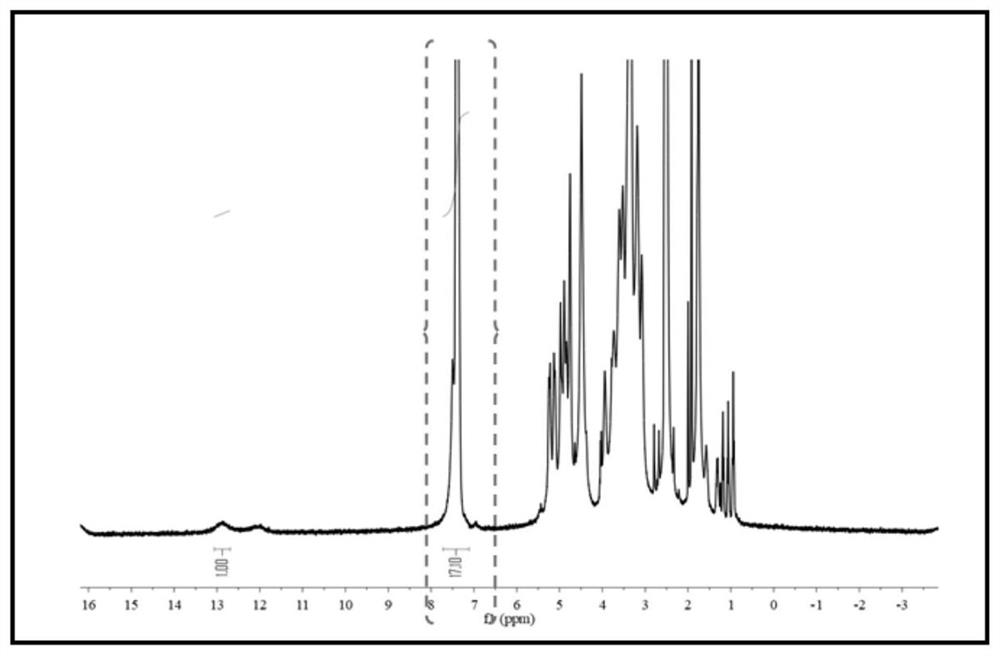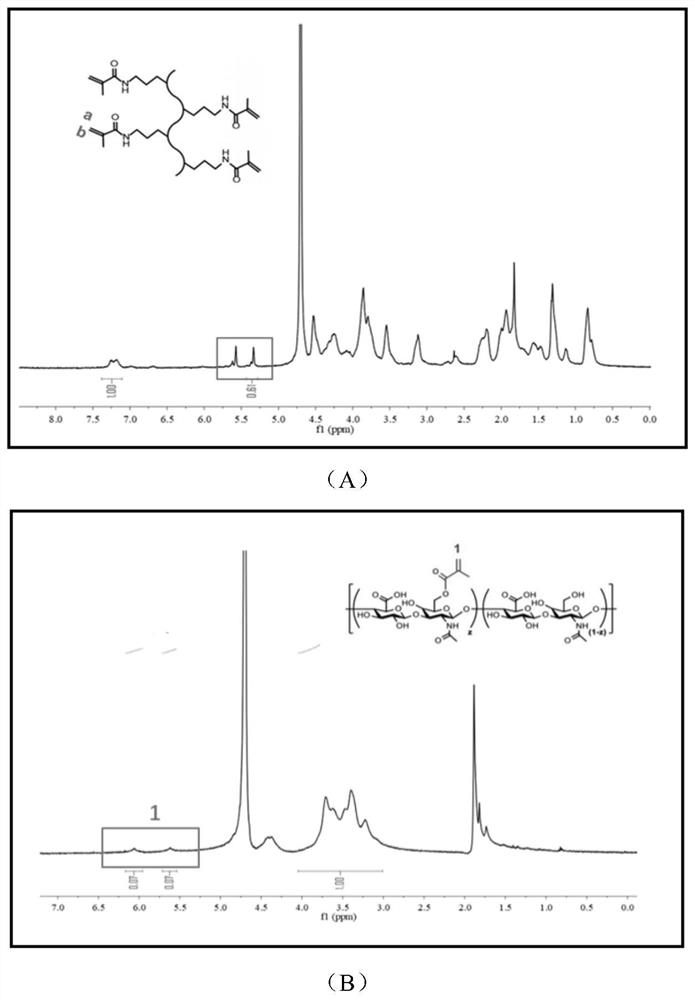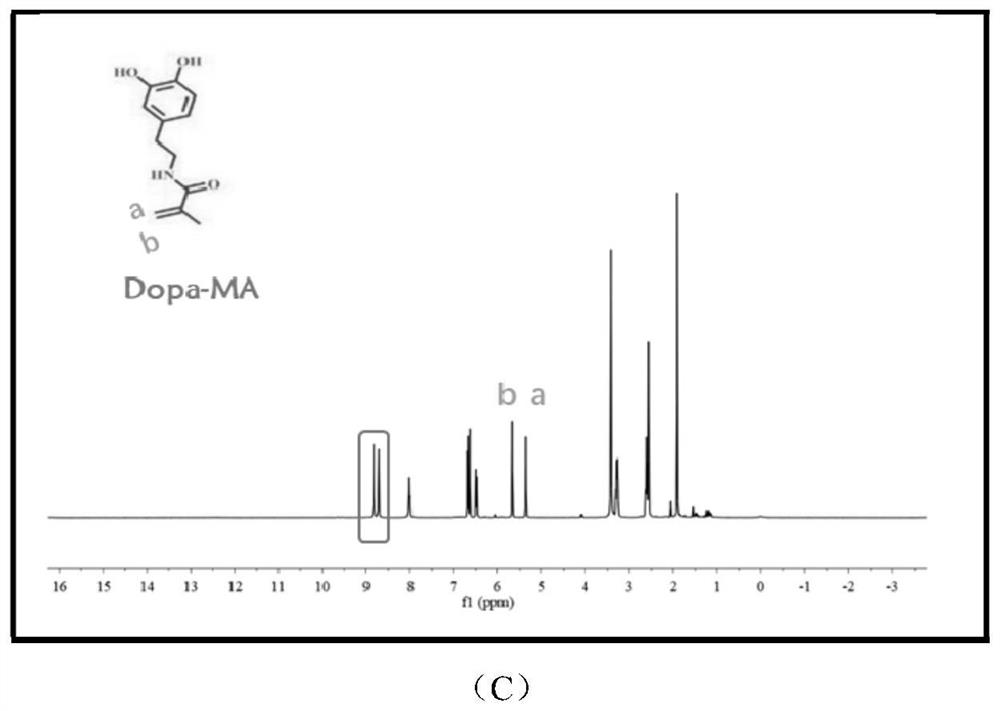Photo-crosslinking injectable nanofiber-hydrogel compound as well as preparation method and application thereof
A nanofiber and composite technology, which is applied in the field of photocrosslinking injectable nanofiber-hydrogel composites and their preparation, can solve the problems of non-injection, lack of skin repair mechanical properties, etc., and achieve good biocompatibility , the effect of enhancing mechanical properties
- Summary
- Abstract
- Description
- Claims
- Application Information
AI Technical Summary
Problems solved by technology
Method used
Image
Examples
Embodiment 1
[0049] In this embodiment, the preparation of hyaluronic acid-benzyl ester (HA-Bn) nanofibers, the steps are as follows:
[0050] (1) Dissolve sodium hyaluronate with a molecular weight of 1000kDa in deionized water to form a sodium hyaluronate solution with a concentration of 10 mg / mL, add Dowex resin to the solution and react for 4 hours until the pH value is stable, and remove the Dowex resin by centrifugation. Then, tetrabutylammonium hydroxide was added to the obtained liquid phase until the pH value was stable, and then the obtained reaction solution was freeze-dried to obtain tetrabutylammonium hyaluronic acid, which was designated as HA-TBA.
[0051] In this step, the addition amount of Dowex resin is 3 times of the mass of sodium hyaluronate, and the addition amount of tetrabutylammonium hydroxide is 2.2 times of the mass of sodium hyaluronate.
[0052] (2) Dissolve HA-TBA in anhydrous dimethyl sulfoxide (DMSO) to form a HA-TBA solution with a concentration of 10mg / mL...
Embodiment 2
[0058] In this example, methacrylylated gelatin (GelMA), methacrylated hyaluronic acid (HAMA), and methacrylated dopamine (Dopa-MA) were prepared respectively, and the steps were as follows:
[0059] (1) Weigh 100g of gelatin and dissolve it in 1.5L of sodium carbonate-sodium bicarbonate buffer solution, add 40mL of methacrylic anhydride dropwise to the resulting solution, react at 50°C for 4h, dialyze the resulting reaction solution and freeze-dry to obtain GelMA .
[0060] (2) Weigh 25g of sodium hyaluronate with a molecular weight of 1000kDa and dissolve it in 1L of deionized water, place the resulting solution on an ice bath, adjust the pH value of the solution to greater than 8.5 with 1mol / L NaOH solution, and slowly add 56.25mL of methacrylic anhydride, during the dropwise addition process, use 1mol / L NaOH solution to maintain the pH value of the reaction system greater than 8.5, remove the ice bath after 4 hours of reaction, continue the reaction for 12 hours, dialyze t...
Embodiment 3
[0070] In this example, a photocrosslinkable injectable nanofiber-hydrogel composite was prepared.
[0071] (1) Dissolve GelMA, HAMA, Dopa-MA and photoinitiator LAP in deionized water to obtain a raw material mixture under dark conditions, and then fully disperse the HA-Bn nanofibers in the raw materials under the action of ultrasound under dark conditions In the mixed solution, the gel precursor solution III was obtained, which was irradiated with 405nm excitation light for 1 min to trigger the cross-linking reaction of GelMA, HAMA and Dopa-MA to obtain the nanofiber-hydrogel composite, which was designated as composite III.
[0072] The mass ratio of GelMA, HAMA, Dopa-MA, LAP to HA-Bn nanofibers was 10:1:0.5:0.5:1, and the concentration of GelMA in gel precursor solution III was 0.01 g / mL.
[0073] (2) Dissolve GelMA, HAMA, Dopa-MA and photoinitiator LAP in deionized water to obtain a raw material mixture under dark conditions, and then fully disperse the HA-Bn nanofibers in...
PUM
| Property | Measurement | Unit |
|---|---|---|
| diameter | aaaaa | aaaaa |
| length | aaaaa | aaaaa |
| diameter | aaaaa | aaaaa |
Abstract
Description
Claims
Application Information
 Login to View More
Login to View More - R&D
- Intellectual Property
- Life Sciences
- Materials
- Tech Scout
- Unparalleled Data Quality
- Higher Quality Content
- 60% Fewer Hallucinations
Browse by: Latest US Patents, China's latest patents, Technical Efficacy Thesaurus, Application Domain, Technology Topic, Popular Technical Reports.
© 2025 PatSnap. All rights reserved.Legal|Privacy policy|Modern Slavery Act Transparency Statement|Sitemap|About US| Contact US: help@patsnap.com



